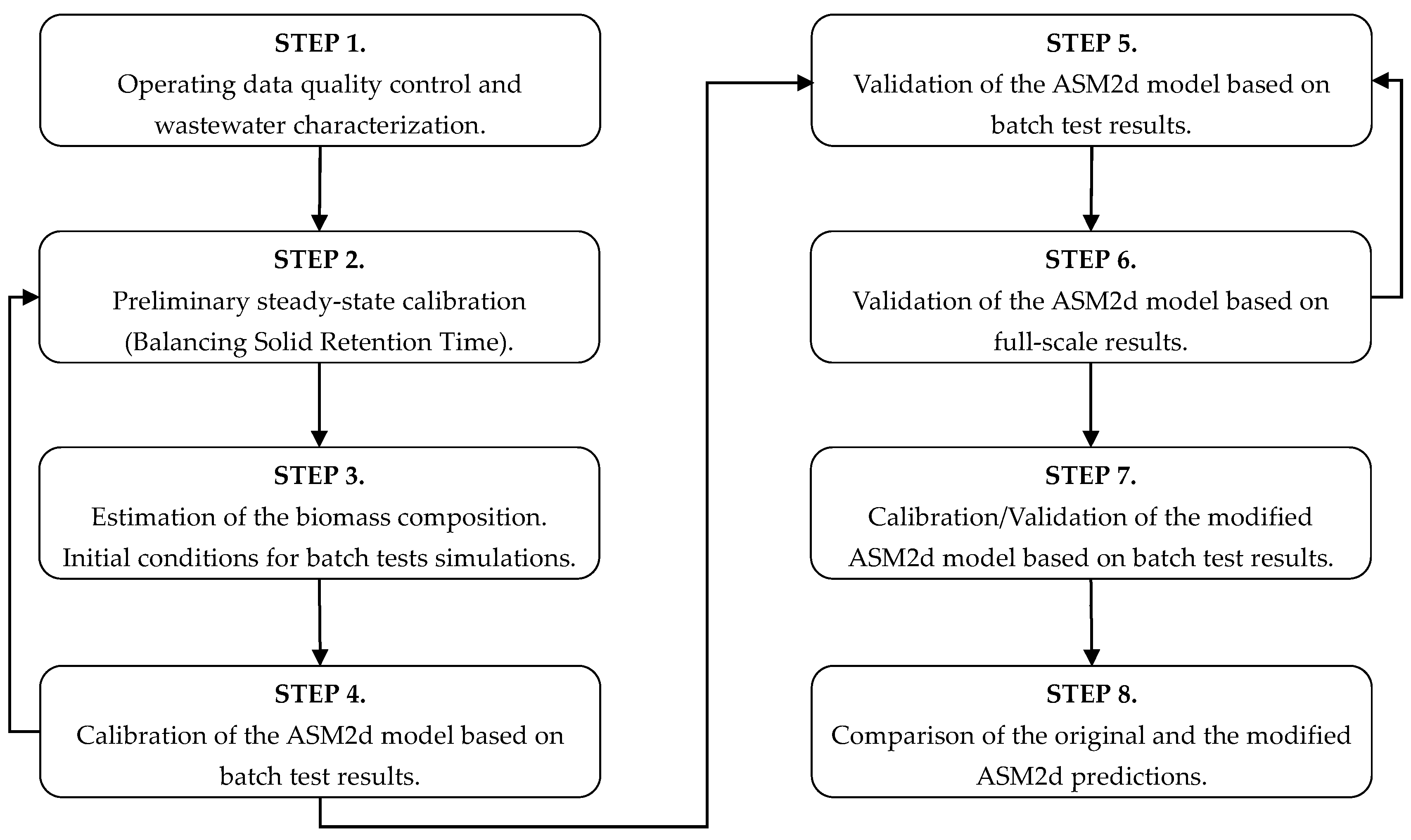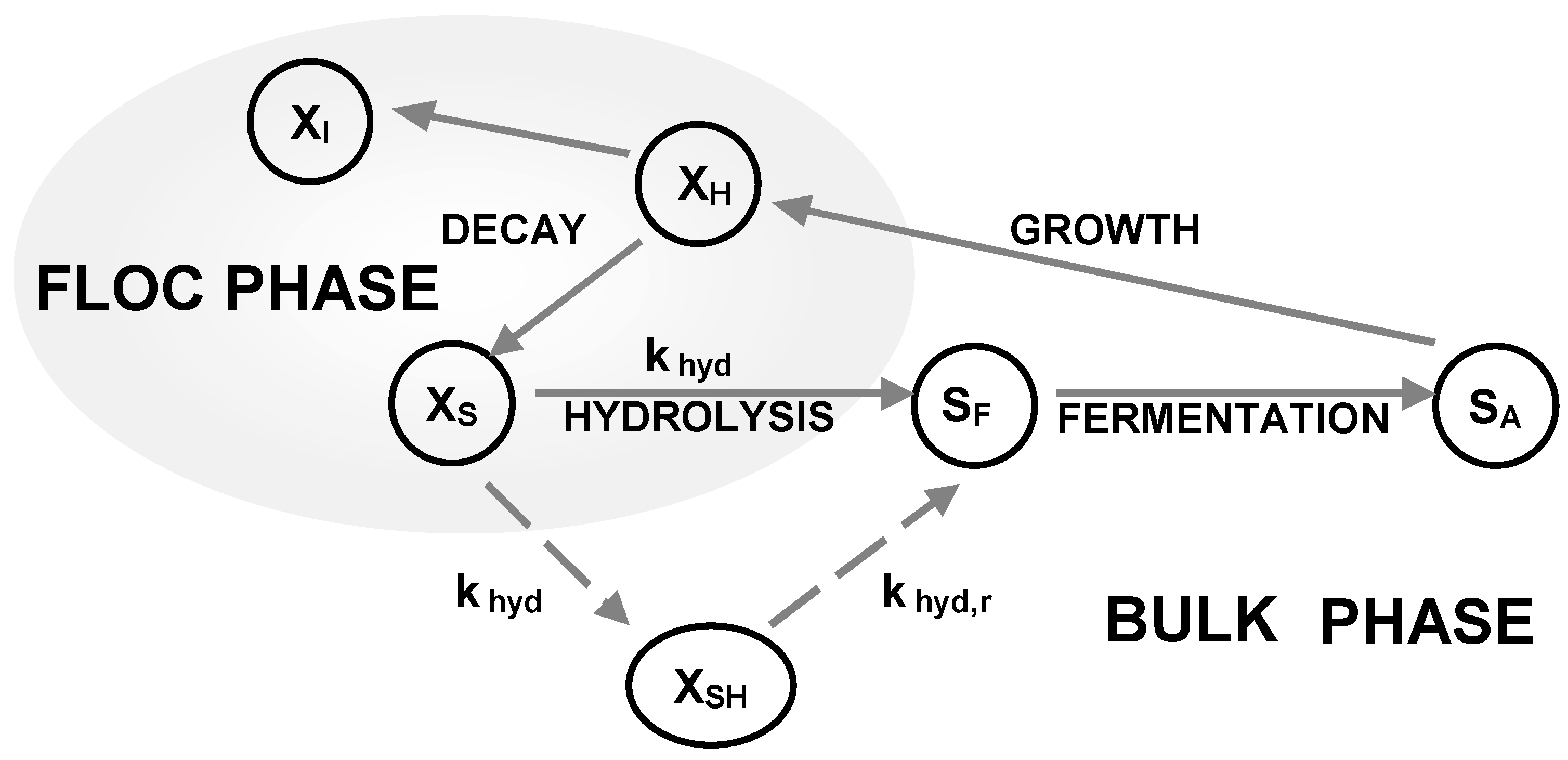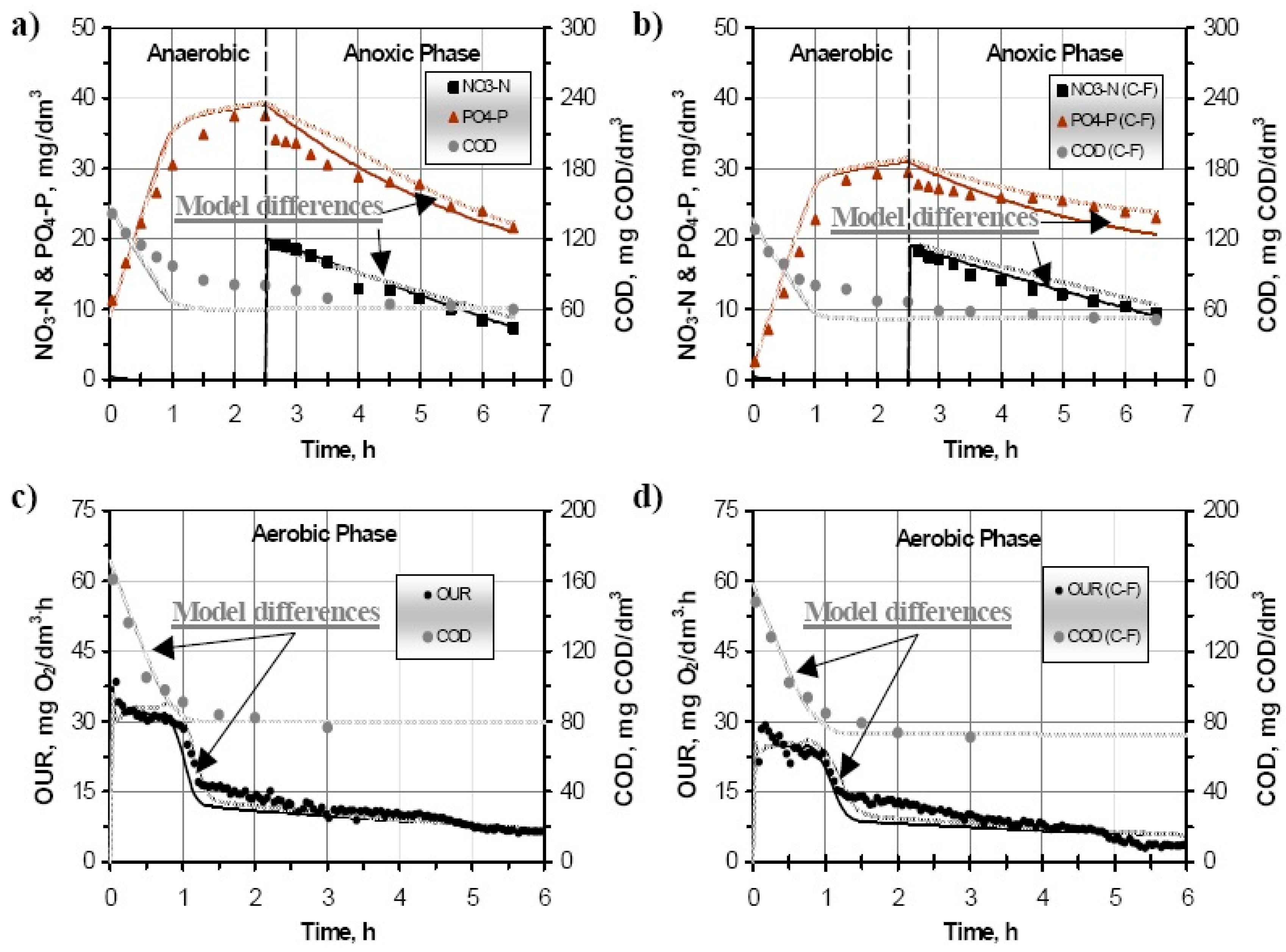Modelization of Nutrient Removal Processes at a Large WWTP Using a Modified ASM2d Model
Abstract
1. Introduction
2. Materials and Methods
2.1. Full-Scale WWTP
2.2. Batch Laboratory Study.
2.3. Analytical Methods
3. Results and Discussion
4. Conclusions
- The modified ASM2d model presented in this work allows reaching more accurate predictions of the behavior of the activated sludge systems taking place in a full scale WWTP than the original ASM2d model. Additionally, more accurate assessment of wastewater biodegradability in terms of the COD fractions was obtained which is crucial for the BNR processes modelization.
- When comparing the original and the modified ASM2d models it was observed that the largest differences in the ARD values were obtained in the predictions of nitrate utilization, up to 9.6%, phosphate uptake, up to 11.3%, and oxygen uptake, up to 5.7%.
- When comparing the original and the modified ASM2d only minor effect were observed on the behavior of COD consumption, phosphate release, and ammonia utilization.
- The effective use of internal C sources, such as slowly biodegradable substrate (XS) for denitrification and biological phosphorous removal may help to reach the quality standards stablished in the EU regulations for large WWTPs.
- From the modelling results, it was observed that the colloidal and particulate organic fractions play a crucial role the enhancement of the denitrification and EBPR at the Debogorze WWTP.
Author Contributions
Funding
Acknowledgments
Conflicts of Interest
References
- Orhon, D.; Cokgor, E.U. COD fractionation in wastewater characterization – The state of the art. J. Chem. Technol. Biotechnol. 1997, 68, 283–293. [Google Scholar] [CrossRef]
- Gujer, W.; Henze, M.; Mino, T.; van Loosdrecht, M.C.M. Activated Sludge Model No. 3. Water Sci. Tech. 1999, 39, 183–193. [Google Scholar] [CrossRef]
- Henze, M.; Gujer, W.; Mino, T.; Matsuo, T.; Wentzel, M.C.; Marais, G.v.R.; van Loosdrecht, M. ASM No. 2d. Water Sci. Tech. 1999, 39, 165–182. [Google Scholar] [CrossRef]
- Lagarde, F.; Tusseau-Vuillemin, M.-H.; Lessard, P.; Heduit, A.; Dutrop, F.; Mouchel J., M. Variability estimation of urban wastewater biodegradable fractions by respirometry. Water Res. 2005, 39, 4768–4778. [Google Scholar] [CrossRef] [PubMed]
- EU Directive. The Council Directive 91/271/EEC Concerning Urban Waste-Water Treatment; Official Journal of the European Communities: Brussels, Belgium, 1991. [Google Scholar]
- Ekama, G.A.; Marais, G.v.R. Dynamic behavior of the activated-sludge process. J. Water Pollut. Control Fed. 1979, 51, 534–556. [Google Scholar]
- Gori, R.; Jiang, L.M.; Sobhani, R.; Rosso, D. Effects of soluble and particulate substrate on the carbon and energy footprint of wastewater treatment processes. Water Res. 2011, 45, 5858–5872. [Google Scholar] [CrossRef] [PubMed]
- Sawyer, C.N. 1955 Bacterial nutrition and synthesis. In Biological Treatment of Sewage and Industrial Wastes; McCabe, J., Eckenfelder, W.W., Eds.; Reinhold Publishing Corp: New York, NY, USA, 1956; pp. 3–17. [Google Scholar]
- Bakos, V.; Kiss, B.; Jobbágy, A. Problems and causes of marginal nutrient availability in winery wastewater treatment. Acta Aliment. 2016, 45, 532–541. [Google Scholar] [CrossRef]
- Jobbágy, A.; Kiss, B.; Bakos, V. Conditions favoring proliferation of Glycogen Accumulating Organisms for excess biological carbon removal in treating nutrient deficient wastewater. Period. Polytech. Chem. Eng. 2017, 61, 149–155. [Google Scholar]
- Drewnowski, J.; Makinia, J. The role of biodegradable particulate and colloidal organic compounds in biological nutrient removal activated sludge systems. Int. J. Environ. Sci. Technol. 2014, 11, 1973–1988. [Google Scholar] [CrossRef]
- Orhon, D.; Cokgor, E.U.; Sozen, S. Dual hydrolysis model of the slowly biodegradable substrate in activated sludge. Bioresour. Technol. 1998, 12, 737–741. [Google Scholar]
- Drewnowski, J.; Remiszewska-Skwarek, A.; Fernandez-Morales, F.J. Model based evaluation of plant improvement at a large wastewater treatment plant (WWTP). J. Environ. Sci. Health Part A 2018, 53, 669–675. [Google Scholar] [CrossRef] [PubMed]
- Grady, C.P.L., Jr.; Daigger, G.T.; Love, N.G.; Filipe, C.D.M. Biological Wastewater Treatment, 3rd ed.; CRC Press: Boca Raton, Florida, FL, USA, 2011. [Google Scholar]
- Drewnowski, J.; Makinia, J. The role of colloidal and particulate organic compounds in denitrification and EBPR occurring in a full-scale activated sludge system. Water Sci. Technol. 2011, 63, 318–324. [Google Scholar] [CrossRef] [PubMed]
- Mamais, D.; Jenkins, D.; Pitt, P. A rapid physical chemical method for the determination of readily biodegradable soluble COD in municipal wastewater. Water Res. 1993, 27, 195–197. [Google Scholar] [CrossRef]
- Swinarski, M.; Makinia, J.; Stensel, H.D.; Czerwionka, K.; Drewnowski, J. Modeling external carbon addition in biological nutrient removal processes with an extension of the international water association activated sludge model. Water Environ. Res. 2012, 84, 646–655. [Google Scholar] [CrossRef]
- Drewnowski, J.; Makinia, J. Modeling hydrolysis of slowly biodegradable organic compounds in biological nutrient removal activated sludge systems. Water Sci. Technol. 2013, 67, 2067–2074. [Google Scholar] [CrossRef] [PubMed]
- APHA Standard Methods for Examination of Water and Wastewater, 18th ed; American Public Health Association: Washington, DC, USA, 1992.
- Bennett, J.O.; Briggs, W.L. Using and Understanding Mathematics: A Quantitative Reasoning Approach, 6th ed.; Pearson: Boston, MA, USA, 2015. [Google Scholar]
- Nelder, J.A.; Mead, R. A simplex method for function minimization. Comput. J. 1965, 7, 308–313. [Google Scholar] [CrossRef]
- Rodríguez, L.; Villaseñor, J.; Buendía, I.M.; Fernández, F.J. Re-use of winery wastewaters for biological nutrient removal. Water Sci. Technol. 2007, 56, 95–102. [Google Scholar]
- Fernández, F.J.; Castro, M.C.; Villasenor, J.; Rodríguez, L. Agro-food wastewaters as external carbon source to enhance biological phosphorus removal. Chem. Eng. J. 2011, 166, 559–567. [Google Scholar]
- De Lucas, A.; Rodríguez, L.; Villaseñor, J.; Fernández, F.J. Biodegradation kinetics of stored wastewater substrates by a mixed microbial culture. Biochem. Eng. J. 2005, 26, 191–197. [Google Scholar] [CrossRef]



| Definition | Symbol | Unit | Monthly Average Value | Source of Data |
|---|---|---|---|---|
| Influent COD | CODin | g COD/m3 | 856 | Laboratory analyses |
| Influent COD in filtered sample | CODf,in | g COD/m3 | 211 | Laboratory analyses |
| Volatile Fatty Acids | VFA | g/m3 | 167 | Laboratory analyses |
| Influent BOD5 | BOD5,in | g BOD5/m3 | 319 | Laboratory analyses |
| Influent Biodegradable COD | BCODin | g COD/m3 | 545 | Calculation [14] |
| Effluent COD | CODout | g COD/m3 | 25.4 | Laboratory analyses |
| Effluent COD in filtered sample | CODf,out | g COD/m3 | 20.5 | Laboratory analyses |
| BOD5/BODU ratio | fBOD | – | 0.67 | Laboratory analyses |
| Symbol | Unit | Original ASM2d | Modified ASM2d |
|---|---|---|---|
| Stoichiometric coefficients | |||
| YH | gCOD/gCOD | 0.625 | 0.68 |
| Kinetic coefficients | |||
| khyd | 1/d | 2.5 | 2 |
| khyd,r | 1/d | - | 10 |
| ηfe | - | 0.1 | 0.1 |
| ηfer | - | - | 0.4 |
| kx | 1/d | 0.2 | 0.1 |
| kxr | 1/d | - | 0.03 |
| ηNO3, Hyd | - | 0.6 | 0.6 |
| ηNO3, Hydr | - | - | 0.4 |
| KO2 | g O2 /m3 | 0.2 | 0.2 |
| KNO3 | g N/m3 | 0.5 | 0.5 |
| Test | Process Rate | ARD Differences between the Original and Modified ASM2d [%] | |||
|---|---|---|---|---|---|
| Settled Wastewater | Coagulation-Flocculation | ||||
| Fall | Spring | Fall | Spring | ||
| NUR | Nitrate utilization | 1.6 | 17.0 | 1.6 | 5.0 |
| Soluble COD utilization | 0.3 | 0.4 | 0.2 | 0.0 | |
| PRR/anoxic PUR | Phosphate release | 0.0 | 0.5 | 0.3 | 0.6 |
| Phosphate uptake | 2.2 | 0.6 | 3.3 | 1.1 | |
| Nitrate utilization | 9.6 | 9.0 | 6.8 | 1.0 | |
| PRR/aerobic PUR | Phosphate release | 0.5 | 0.1 | 0.8 | 0.1 |
| Phosphate uptake | 5.9 | 1.9 | 11.3 | 4.4 | |
| Ammonia utilization | 0.2 | 0.3 | 0.4 | 0.2 | |
| Oxygen uptake | 5.4 | 5.6 | 1.5 | 1.2 | |
| OUR | Oxygen uptake | 0.8 | 0.7 | 5.7 | 4.4 |
| SCOD utilization | 0.3 | 0.4 | 0.2 | 1.1 | |
© 2018 by the authors. Licensee MDPI, Basel, Switzerland. This article is an open access article distributed under the terms and conditions of the Creative Commons Attribution (CC BY) license (http://creativecommons.org/licenses/by/4.0/).
Share and Cite
Drewnowski, J.; Makinia, J.; Kopec, L.; Fernandez-Morales, F.-J. Modelization of Nutrient Removal Processes at a Large WWTP Using a Modified ASM2d Model. Int. J. Environ. Res. Public Health 2018, 15, 2817. https://doi.org/10.3390/ijerph15122817
Drewnowski J, Makinia J, Kopec L, Fernandez-Morales F-J. Modelization of Nutrient Removal Processes at a Large WWTP Using a Modified ASM2d Model. International Journal of Environmental Research and Public Health. 2018; 15(12):2817. https://doi.org/10.3390/ijerph15122817
Chicago/Turabian StyleDrewnowski, Jakub, Jacek Makinia, Lukasz Kopec, and Francisco-Jesus Fernandez-Morales. 2018. "Modelization of Nutrient Removal Processes at a Large WWTP Using a Modified ASM2d Model" International Journal of Environmental Research and Public Health 15, no. 12: 2817. https://doi.org/10.3390/ijerph15122817
APA StyleDrewnowski, J., Makinia, J., Kopec, L., & Fernandez-Morales, F.-J. (2018). Modelization of Nutrient Removal Processes at a Large WWTP Using a Modified ASM2d Model. International Journal of Environmental Research and Public Health, 15(12), 2817. https://doi.org/10.3390/ijerph15122817








